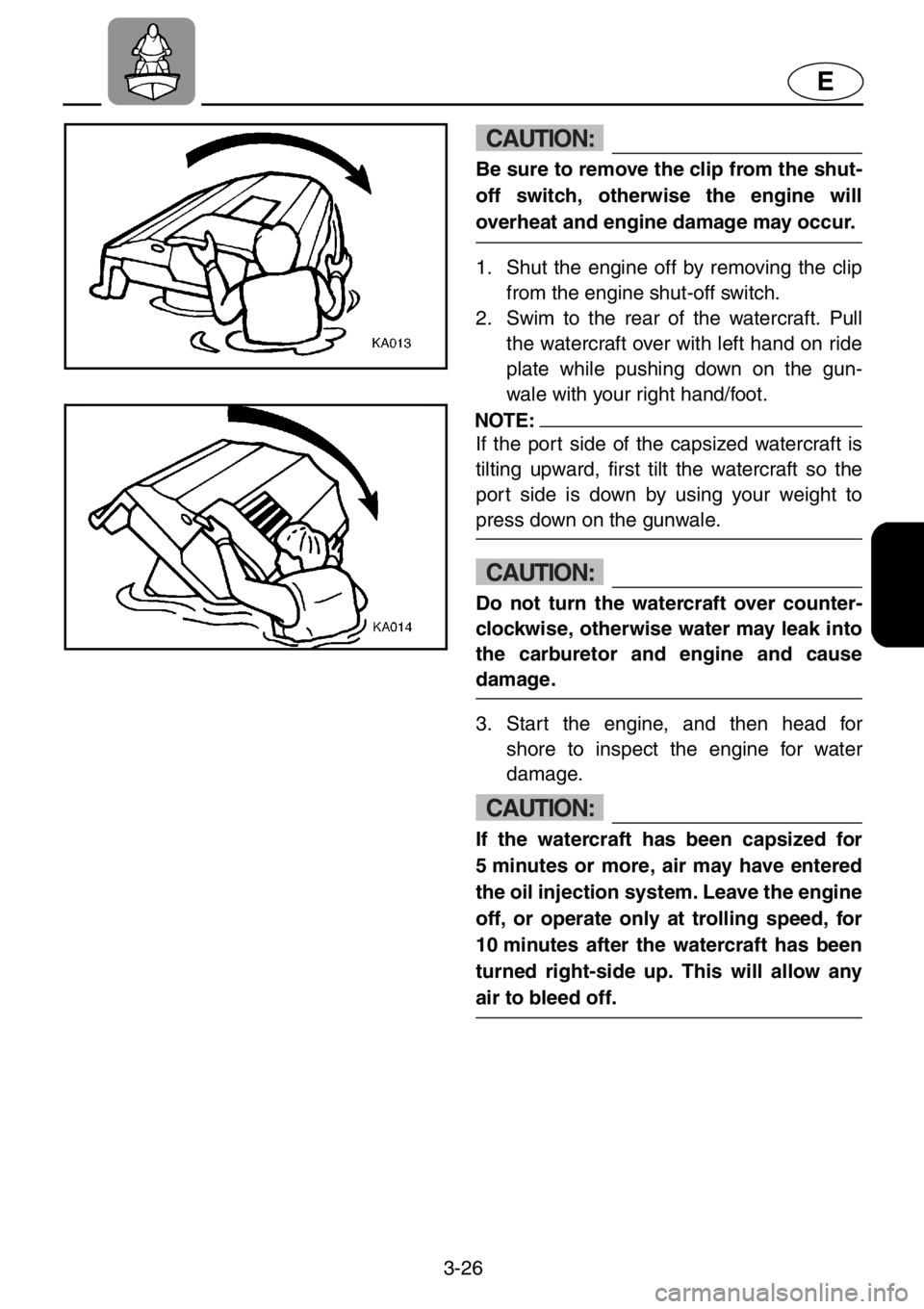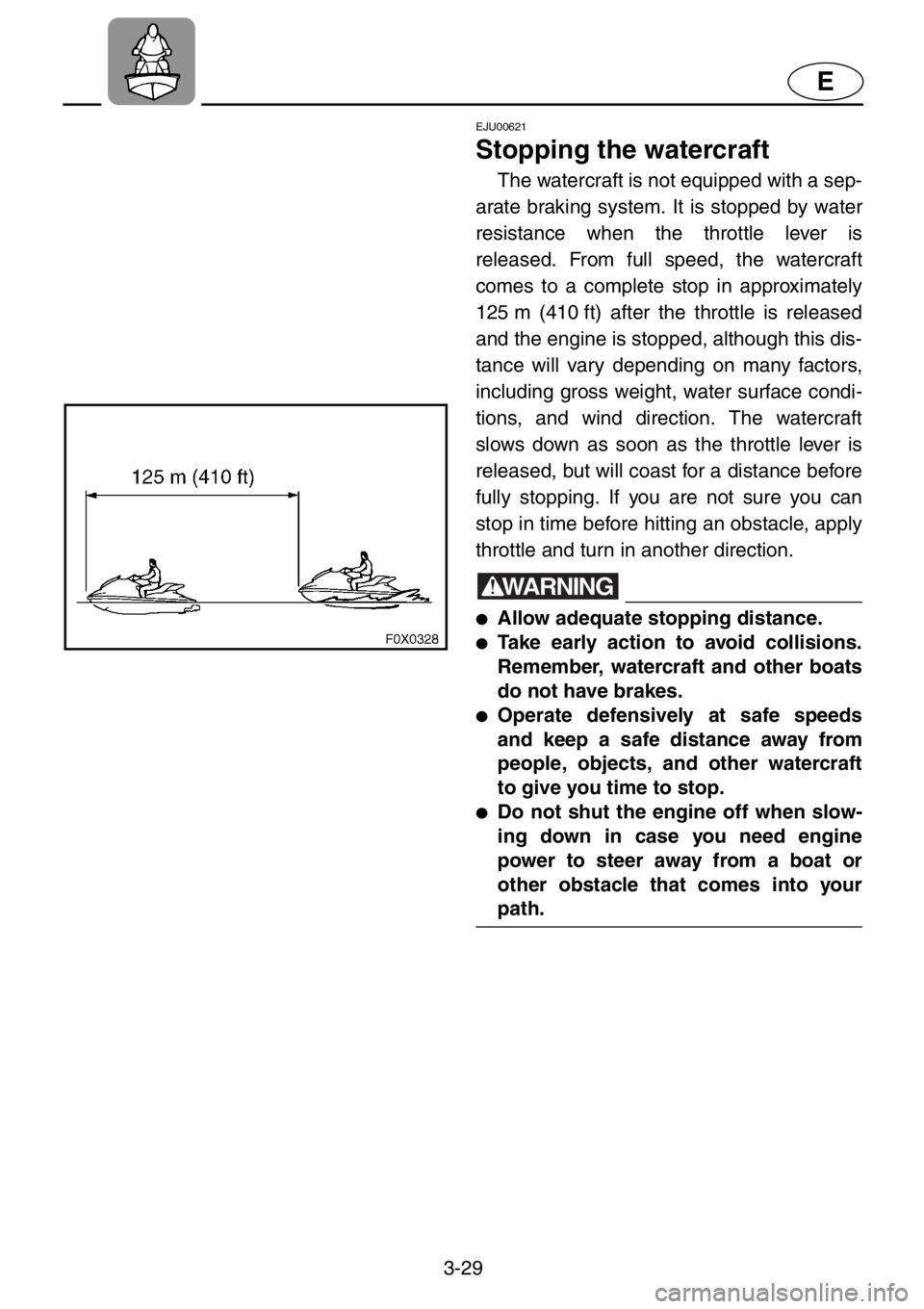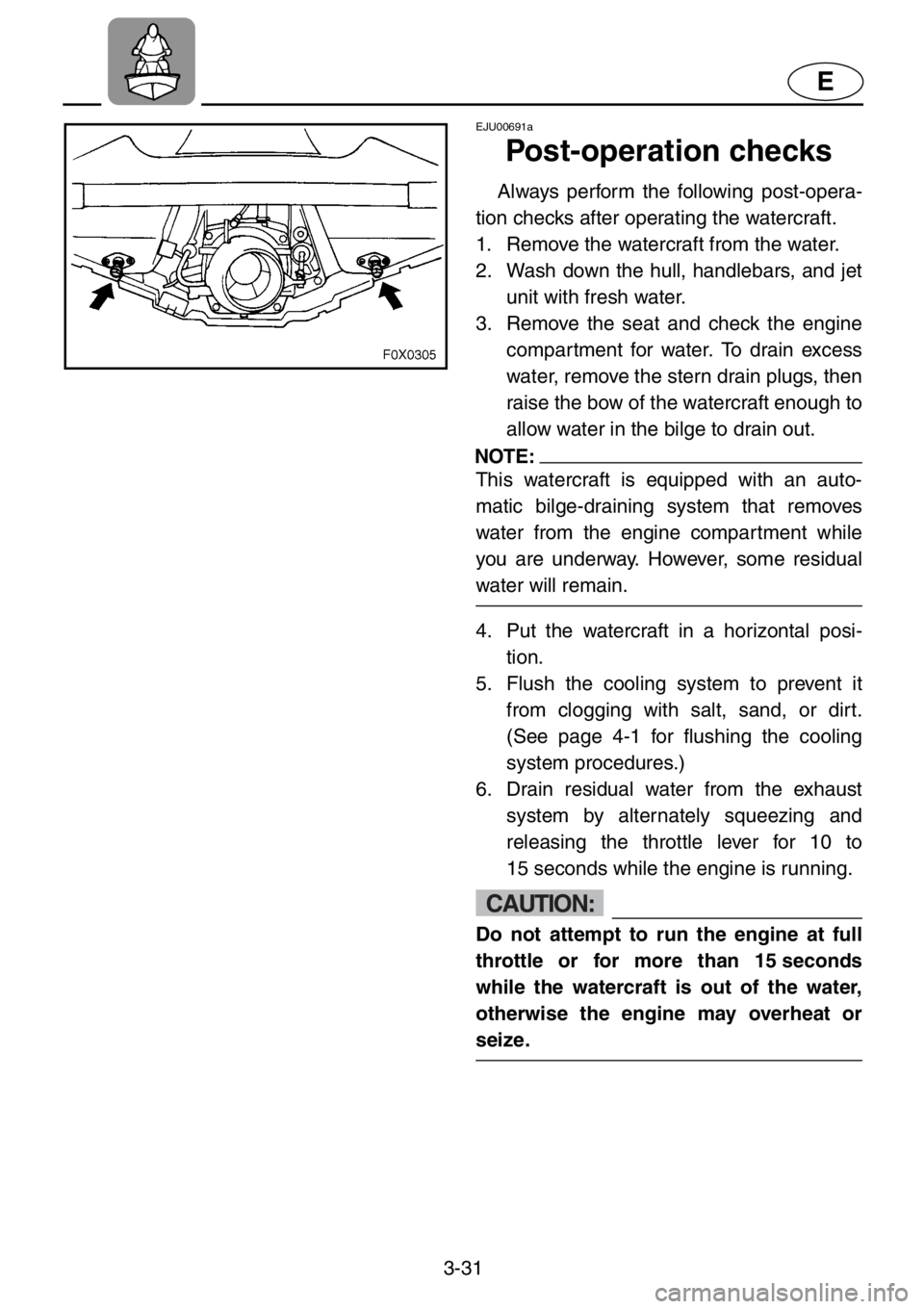YAMAHA GP1200 2001 Manual PDF
Manufacturer: YAMAHA, Model Year: 2001, Model line: GP1200, Model: YAMAHA GP1200 2001Pages: 119, PDF Size: 12.42 MB
Page 71 of 119

3-26
E
CAUTION:
Be sure to remove the clip from the shut-
off switch, otherwise the engine will
overheat and engine damage may occur.
1. Shut the engine off by removing the clip
from the engine shut-off switch.
2. Swim to the rear of the watercraft. Pull
the watercraft over with left hand on ride
plate while pushing down on the gun-
wale with your right hand/foot.
NOTE:
If the port side of the capsized watercraft is
tilting upward, first tilt the watercraft so the
port side is down by using your weight to
press down on the gunwale.
CAUTION:
Do not turn the watercraft over counter-
clockwise, otherwise water may leak into
the carburetor and engine and cause
damage.
3. Start the engine, and then head for
shore to inspect the engine for water
damage.
CAUTION:
If the watercraft has been capsized for
5 minutes or more, air may have entered
the oil injection system. Leave the engine
off, or operate only at trolling speed, for
10 minutes after the watercraft has been
turned right-side up. This will allow any
air to bleed off.
Page 72 of 119

3-27
E
EJU00499
Turning the watercraft
Steering control depends on the combi-
nation of handlebar position and the amount
of throttle.
Water sucked in through the intake grate
is pressurized by the impeller in the jet
pump. As the pressurized water is expelled
from the pump through the jet thrust nozzle,
it creates thrust to move and steer the
watercraft. The higher the engine speed, the
more thrust is produced.
The amount of jet thrust, in addition to the
position of the handlebars, determines how
sharply you turn.
A. More throttle produces higher thrust, so
the watercraft will turn more sharply.
B. Less throttle produces lower thrust, so
the watercraft will turn more gradually.
C. Releasing the throttle completely pro-
duces only minimum thrust. If you are
traveling at speeds above trolling, you
will have rapidly decreasing ability to
steer without throttle. You may still have
some turning ability immediately after
releasing the throttle, but once the
engine slows down, the watercraft will no
longer respond to handlebar input until
you apply throttle again or you reach a
trolling speed.
At trolling speed, the watercraft can be
turned gradually by handlebar position
alone using just the amount of thrust
available at idle.
D. If the engine is stopped while riding,
there is no thrust. The watercraft will go
straight even though the handlebars are
turned.
You need throttle to steer.
Page 73 of 119

3-28
E
WARNING
●Do not release the throttle when trying
to steer away from objects—you need
throttle to steer. A collision could
result in severe injury or death.
●When operating at higher speeds,
make gradual turns or slow down
before turning. Sharp high-speed turns
may cause the watercraft to slide side-
ways or spin, throwing the operator
and passengers overboard which
could cause an injury.
Page 74 of 119

3-29
E
EJU00621
Stopping the watercraft
The watercraft is not equipped with a sep-
arate braking system. It is stopped by water
resistance when the throttle lever is
released. From full speed, the watercraft
comes to a complete stop in approximately
125 m (410 ft) after the throttle is released
and the engine is stopped, although this dis-
tance will vary depending on many factors,
including gross weight, water surface condi-
tions, and wind direction. The watercraft
slows down as soon as the throttle lever is
released, but will coast for a distance before
fully stopping. If you are not sure you can
stop in time before hitting an obstacle, apply
throttle and turn in another direction.
WARNING
●Allow adequate stopping distance.
●Take early action to avoid collisions.
Remember, watercraft and other boats
do not have brakes.
●Operate defensively at safe speeds
and keep a safe distance away from
people, objects, and other watercraft
to give you time to stop.
●Do not shut the engine off when slow-
ing down in case you need engine
power to steer away from a boat or
other obstacle that comes into your
path.
Page 75 of 119

3-30
E
EJU00635
Beaching the watercraft
1. Make sure no obstructions, boats or
swimmers are near the beach. Release
the throttle lever about 125 m (410 ft)
before you reach the intended beaching
area.
2. Approach the beach slowly and stop the
engine before reaching land. Remem-
ber: you need throttle to steer.
3. Get off the watercraft and pull it up on
the beach.
CAUTION:
Small pebbles, sand, seaweed, and other
debris can be pulled into the jet intake
and impair or damage the impeller.
Always stop the engine and get off
before beaching the watercraft.
EJU00505
Docking the watercraft
1. Make sure that no obstructions, boats or
swimmers are close to the watercraft.
Reduce speed about 125 m (410 ft)
away from the dock.
2. Slowly approach the dock and stop the
engine just before coming alongside it.
EJU00507
Rough water operation
The force of landing after jumping can
cause a strong impact on both the watercraft
and the operator and passenger. It is possi-
ble for the operator to hit his or her chest or
jaw on the watercraft body or handlebars
and be injured. Do not operate the water-
craft with your chin right above the handle-
bars or with your feet outside the watercraft.
Operating in rough water or jumping waves
can also crack the watercraft body or dam-
age internal parts. Avoid operating in rough
water or bad weather conditions.
Page 76 of 119

3-31
E
EJU00691a
Post-operation checks
Always perform the following post-opera-
tion checks after operating the watercraft.
1. Remove the watercraft from the water.
2. Wash down the hull, handlebars, and jet
unit with fresh water.
3. Remove the seat and check the engine
compartment for water. To drain excess
water, remove the stern drain plugs, then
raise the bow of the watercraft enough to
allow water in the bilge to drain out.
NOTE:
This watercraft is equipped with an auto-
matic bilge-draining system that removes
water from the engine compartment while
you are underway. However, some residual
water will remain.
4. Put the watercraft in a horizontal posi-
tion.
5. Flush the cooling system to prevent it
from clogging with salt, sand, or dirt.
(See page 4-1 for flushing the cooling
system procedures.)
6. Drain residual water from the exhaust
system by alternately squeezing and
releasing the throttle lever for 10 to
15 seconds while the engine is running.
CAUTION:
Do not attempt to run the engine at full
throttle or for more than 15 seconds
while the watercraft is out of the water,
otherwise the engine may overheat or
seize.
Page 77 of 119

3-32
E
7. If the watercraft will be stored for a week
or more, lubricate internal engine com-
ponents to help prevent corrosion. (See
page 4-3 for lubrication procedures.)
8. Rinse the engine and engine compart-
ment with a small amount of water.
CAUTION:
Do not use high pressure when rinsing
the engine or engine compartment as
severe engine damage could result.
9. Wipe the engine and engine compart-
ment dry with a clean cloth (repeat
step 3, if necessary).
10. Wipe the hull, handlebars, and jet unit
dry with a clean cloth.
11. Spray a rust inhibitor on metallic parts to
minimize corrosion.
12. Allow the engine compartment to air dry
completely before reinstalling the seat.
Page 78 of 119

3-33
E
EJU00679
Transporting
WARNING
Always place the fuel cock knob in the
“OFF” position when transporting the
watercraft, otherwise fuel could leak out
into the engine or engine compartment,
which would create a fire hazard.
When transporting the watercraft on a
trailer, secure the tie downs to the trailer
through the bow eye and stern rope holes.
CAUTION:
Do not route ropes or tie downs over the
seat, as they may leave permanent marks
on the seat’s surface. Also, wrap the
ropes or tie downs with towels or rags
where they touch the body of the water-
craft to avoid scratching or damage.
Page 79 of 119

E
4
EJU00515
MAINTENANCE AND
CARE
Storage....................................................... 4-1
Flushing the cooling system ................... 4-1
Lubrication............................................... 4-3
Fuel system............................................. 4-3
Battery ..................................................... 4-4
Cleaning the watercraft........................... 4-5
Maintenance and adjustments............... 4-6
Owner’s/Operator’s Manual and tool
kit ............................................................. 4-7
Periodic maintenance chart .................... 4-8
Inspecting the fuel system ...................... 4-9
Inspecting the oil injection system........ 4-11
Inspecting the steering cable................ 4-12
Inspecting and adjusting the throttle
cable ...................................................... 4-12
Inspecting the QSTS mechanism ........ 4-13
Cleaning and adjusting the spark
plugs ...................................................... 4-14
Lubrication points .................................. 4-15
Inspecting the battery ........................... 4-18
Adjusting the carburetor ....................... 4-20
Replacing the fuse ................................ 4-21
Bleeding the oil injection pump............. 4-21
Adjusting the Yamaha Adjustable
Sponson (Y.A.S.) .................................. 4-22
Specifications......................................... 4-23
Page 80 of 119

4-1
E
EJU00516a
Storage
WARNING
Always place the fuel cock knob in the
“OFF” position when storing the water-
craft, otherwise fuel could leak out into
the engine or engine compartment,
which would create a fire hazard.
Storage for prolonged periods of time,
such as winter storage, requires preventa-
tive maintenance to ensure against deterio-
ration. It is advisable to have the watercraft
serviced by a Yamaha dealer prior to stor-
age. However, the following procedures can
be performed by the owner.
EJU00913a
Flushing the cooling system
Flushing the cooling system is essential
to prevent the cooling system from being
clogged with salt, sand, or dirt.
CAUTION:
●Do not supply water to the cooling
water passages when the engine is not
running. The water could flow back
through the muffler into the crankcase
causing severe engine damage.
●Do not run the engine for more
15 seconds without supplying water,
otherwise the engine may overheat.